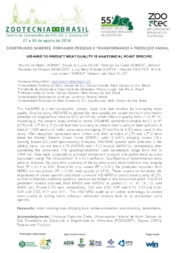VIS-NIRS to predict meat quality is anatomical point specific.
VIS-NIRS to predict meat quality is anatomical point specific.
Author(s): BONIN, M. de N.; SILVA, S. da L. e; GOMES, R. da C.; MENEZES, G. R. de O.; SURITA, L. M. A.; FAVERO, R.; FERRAZ, A. L. J.; FEIJO, G. L. D.
Summary: The Vis-NIRS is a non-destructive, simple, rapid, and safe method for evaluating meat quality. Studies using VIS/NIRS to predict the meat quality are based mainly in information collected on longissimus thoracis (LT), at 12th rib, which differs in quality from LT at 5th rib. Accordingly, the present study aimed to create VIS/NIRS calibrations models for LT at 5th (LT5) and 12th rib (LT12) and test their accuracy to predict meat quality of beef samples. A total of 1,508 steer and heifer carcasses, averaging 20 months (± 4.00) were used in this study.
Publication year: 2018
Types of publication: Abstract in annals or event proceedings
Unit: Embrapa Beef Cattle
Keywords: Color, Cooking loss, Dripping loss, Meat tenderness, Online evaluation, Spectroscopy
Observation
Some of Embrapa's publications are published as ePub files. To read them, use or download one of the following free software options to your computer or mobile device. Android: Google Play Books; IOS: iBooks; Windows and Linux: Calibre.
Access other publications
Access the Agricultural Research Database (BDPA) to consult Embrapa's full library collection and records.
Visit Embrapa Bookstore to purchase books and other publications sold by Embrapa.

